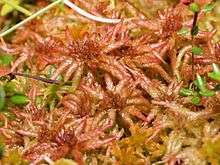Sphagnum magellanicum
Sphagnum magellanicum, commonly called Magellanic bogmoss,[2] Magellan's sphagnum,[3] Magellan's peatmoss or midway peat moss, is a widespread species of moss found in wet boreal forest in the far south and southwest of South America, North America and Eurasia.[2]
| Sphagnum magellanicum | |
|---|---|
 | |
| Scientific classification | |
| Kingdom: | Plantae |
| Division: | Bryophyta |
| Class: | Sphagnopsida |
| Subclass: | Sphagnidae |
| Order: | Sphagnales |
| Family: | Sphagnaceae |
| Genus: | Sphagnum |
| Species: | S. magellanicum |
| Binomial name | |
| Sphagnum magellanicum | |
| Synonyms[1] | |
| |
Description
The red-purple colour visible all or parts of the leaves is very distinctive. It forms low cushions and mats within freshwater bogs.[4]
Conservation
In the 2010s Sphagnum peat in Chile has begun to be harvested at large scales for export to countries like Japan, South Korea, Taiwan and the United States. Given Sphagnums property to absorb excess water and release it during dry months harvesting of Sphagnum, means that overexploitation may threaten the water supply in the fjords and channels of Chile.[5] Extraction of Sphagnum in Chile is regulated by law since August 2, 2018.[6] Since 2018 Chilean law allows only for the manual extraction of Sphagnum using only pitchforks or similar tools as aid.[7] In a given area (polygon) at least 30% of Sphagnum coverage has to be left unharvested.[7] Harvested Sphagnum fibers may not exceed 15 cm in length and the remaining Sphagnum after harvest may never have a length less than 5 cm over the water table.[7] In the regions of Los Ríos (40°S) and Los Lagos (41–43°S) the same plots may be harvested after 12 years, while further south in Aysén (44–48°S) and Magallanes (49–56°S) 85 years have to pass before the same area is harvested again.[7]
References
- Tropicos
- Edwards, Sean R. (2012). English Names for British Bryophytes. British Bryological Society Special Volume. 5 (4 ed.). Wootton, Northampton: British Bryological Society. ISBN 978-0-9561310-2-7. ISSN 0268-8034.
- "Sphagnum magellanicum". Natural Resources Conservation Service PLANTS Database. USDA. Retrieved 25 November 2015.
- Amphlett, Andy; Payne, Sandy. "Sphagnum magellanicum Magellanic Bog-moss" (PDF). Royal Botanic Garden, Edinburgh. Retrieved 13 October 2019.
- Molinet, Carlos; Solari, María Eugenia; Díaz, Manuel; Marticorena, Francisca; Díaz, Patricio A.; Navarro, Magdalena; Niklitschek, Edwin (2018). "Fragmentos de la historia ambiental del sistema de fiordos y canales nor-patagónicos, Sur de Chile: Dos siglos de explotación". Magallania (in Spanish). 46 (2): 107–128.
- "Ministerio de Agricultura dicta decreto que regula extracción de musgo de turberas". Chile Sustentable (in Spanish). 2018-02-18. Retrieved 2019-07-14.
- "DISPONE MEDIDAS PARA LA PROTECCIÓN DEL MUSGO SPHAGNUM MAGELLANICUM". leychile.cl (in Spanish). Biblioteca del Congreso Nacional. 2017-08-02. Retrieved 2019-07-17.